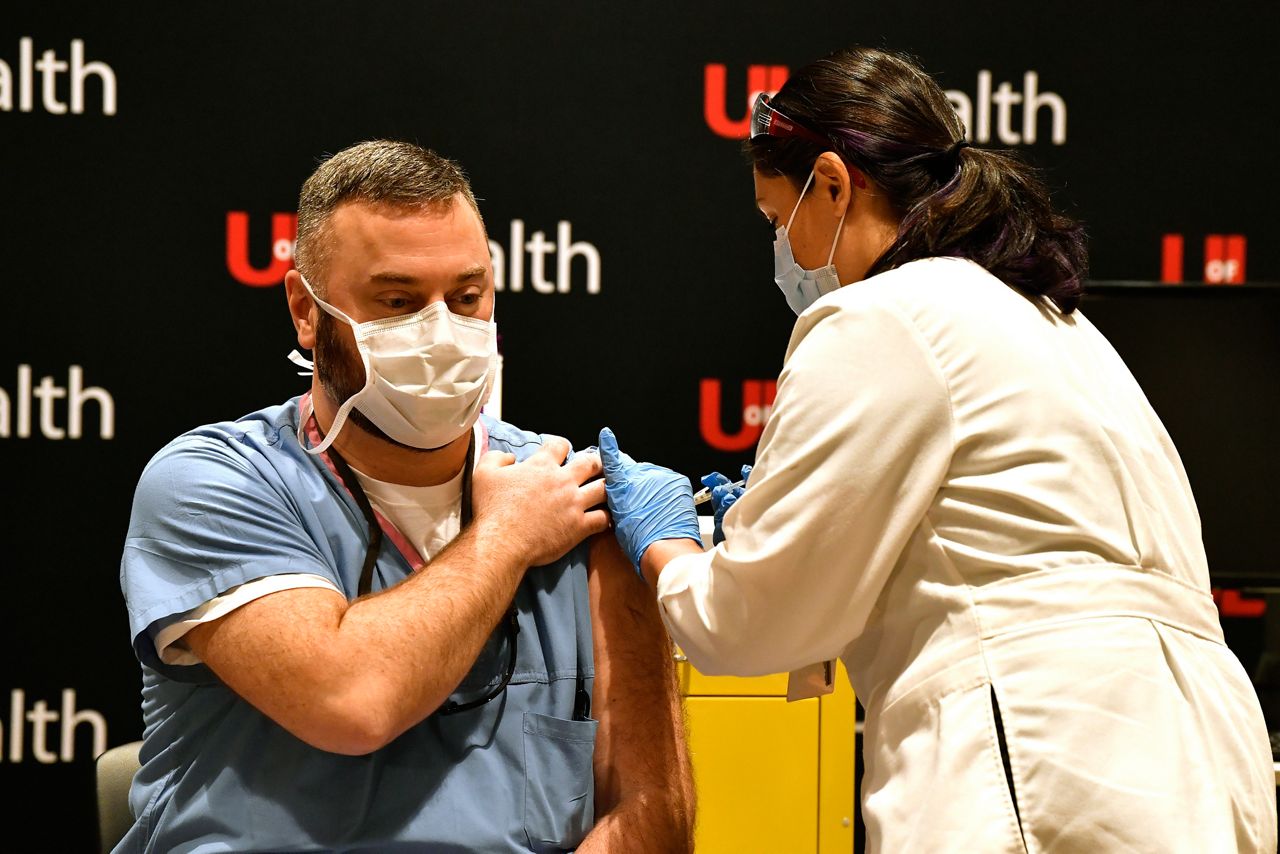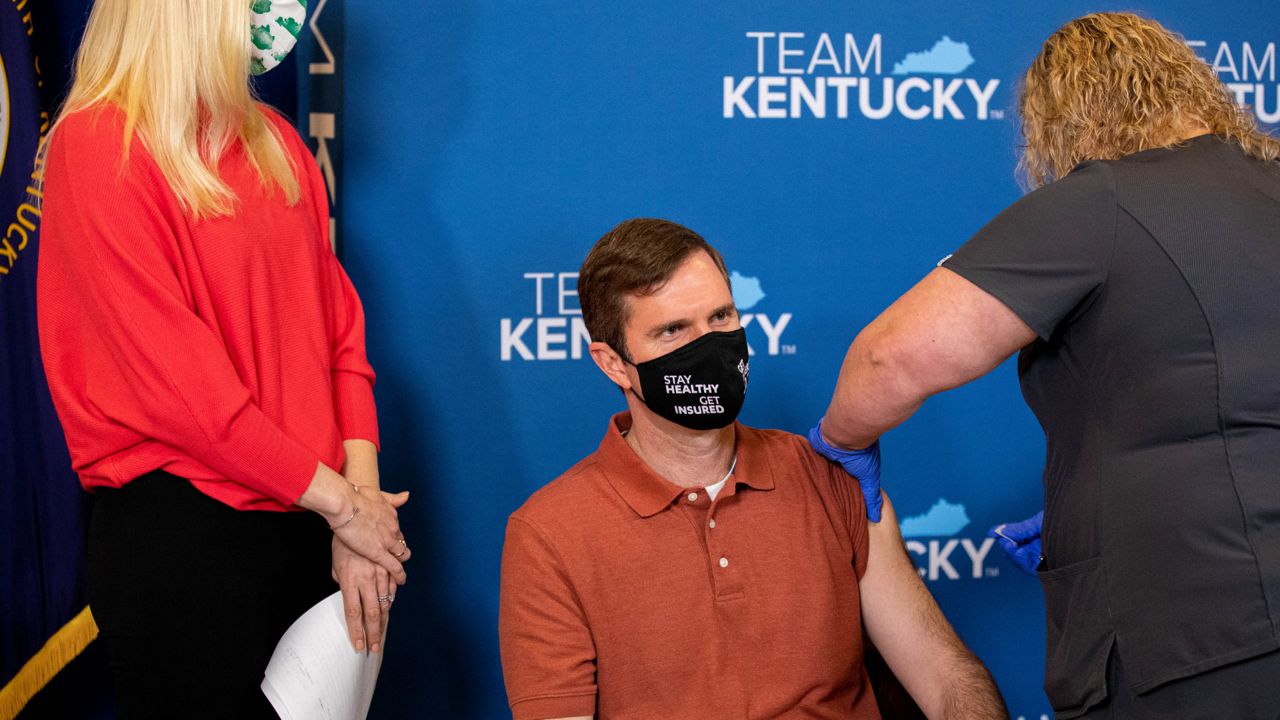LOUISVILLE, Ky. — On Feb. 27, 2020, when Gov. Andy Beshear delivered his first address on the novel coronavirus that causes COVID-19, Kentucky hadn’t yet seen a confirmed case. Schools, workplaces, and restaurants were open. Two nights later, the University of Kentucky basketball team would play in front of 20,638 people at Rupp Arena.
Exactly one year later, on Feb. 27, 2021, Kentucky had been through three waves of COVID-19, more than 400,000 cases, and close to 5,000 deaths. Numbers once unfathomable had become routine.
But the one-year anniversary of Beshear's first public address on COVID-19 also offered something novel: A ray of hope.
For the third time since December, the Food and Administration (FDA) gave emergency use authorization to a COVID-19 vaccine. The vaccination from Johnson & Johnson, which joined those from Pfizer and Moderna, promised to increase supply, improve distribution equity, and help bring a much-anticipated end to the pandemic -- what a difference a year makes.
In Feb. 2020, a COVID-19 vaccine was hardly on the radar. Kentucky Public Health Commissioner Dr. Steven Stack joined Beshear at that initial briefing and made one passing mention of a vaccine. Virus mitigation, for the time being, would require staying at home, wearing a mask, and frequent hand washing, he said.
Over the next several months, as COVID-19 arrived in Kentucky and the state joined the rest of the country on lockdown, the arrival of a vaccine seemed a long way off.
“Just remember: The vaccine won’t be until 2021 at the soonest,” Stack said at an April media briefing. His timeline was even more optimistic than the 18 months Dr. Anthony Fauci suggested. Then-President Donald Trump, meanwhile, was far more bullish. “Vaccine work is looking VERY promising, before end of year,” he tweeted in May.
It took Kentucky’s leaders several months to get on the same page as Trump, and even once they did, they were more cautious in their projections. Stack said in mid-October that the “typical American” should not expect to be vaccinated until early summer of 2021.
On Dec. 13, two days after the FDA gave emergency approval to Pfizer's COVID-19 vaccine, shipments began arriving in Louisville. Thousands of doses moved through the UPS Worldport hub, many on their way to other states, and some meant for the Commonwealth.
By the next day, the first Kentuckians were vaccinated against COVID-19 at the University of Louisville Hospital. “We are here this morning at the University of Louisville Hospital to mark the true beginning of the end of this pandemic,” Beshear said. “And hopefully, while it starts here, it spreads out across this country and across this world.”

Over the next few weeks, doses of the vaccines from Pfizer and Moderna, approved on Dec. 18, began rolling out to sites across the state. They were sent to long-term care centers, hospitals, and local health departments.
But the good news of the vaccine’s arrival was soon dampened by the logistical challenge of rolling it out. “Let me be clear: I am not satisfied by the pace of vaccination here in Kentucky,” Beshear said in his first press conference of 2021. The reasons for the delayed pace included the vaccine’s arrival during the chaotic holiday season and the need to create new reporting systems.
“You can’t underestimate the impediment it was to have so much new stuff, so much uncertainty in quantities, new data systems, end of the year major holidays, and an exhausted health care workforce -- all of this coming together in the first two weeks of the rollout,” Stack said in early January.
As January wore on and the early rollout issues began to clear up, a new problem replaced them: There simply weren’t enough doses. Like much of the country, Kentucky faced significantly more demand than supply. “I’ll just tell you the quantities are insufficient,” Stack said in early February. “The vaccine quantities are not enough for the task at hand.”
On Feb. 9, Beshear announced that 10% of Kentuckians had been vaccinated against COVID-19. But he also revealed data showing that the distribution was not equitable, with only 4.3% of shots going to the state’s Black population, which makes up more than 8% of cases.
"That’s not acceptable," Beshear said. "It needs to be closer at least to the 8%, which is the makeup of the population.” To address this problem, efforts were made to set up vaccination sites at Black churches. Black leaders also publicly received the vaccine.
Some rural residents also had trouble accessing vaccination sites and making appointments online. The state addressed these inequities by opening regional vaccination centers, more than a dozen of which are in eastern Kentucky, and partnering with independent pharmacies that serve rural areas.
Good news came from Washington, D.C., in late February when the federal government announced plans to ship significantly more doses of COVID-19 vaccines to Kentucky and other states. Despite disruptive winter weather, the pace of vaccination has ramped up in recent weeks, spurred on by the increased supply, approval of a third COVID-19 vaccine, and opening of more than 400 vaccination sites.
As of March 9, 868,035 Kentuckians have been vaccinated, with more than 127,000 coming in the week between March 2 and March 9. At a press conference this week, Beshear said many more would soon join them.
“We are going to meet the goal the president set of having a vaccine available for any Kentucky adult that wants one by the end of May,” he said.
As the vaccine supply has increased, the pandemic has also come under more control. Kentucky has seen eight straight weeks of falling case counts, which are now on par with last September. After a winter in which nearly every one of the state’s 120 counties was seeing the highest level of community spread, most have now dropped below 25 cases per 100,000 residents. Nearly every school district has returned to some level of in-person learning. And COVID-19 deaths are on the decline.
A year after the virus arrived in Kentucky, an end to the pandemic in the Bluegrass appears in nearly sight, Beshear said this week.
"Stay patient. Stay vigilant," he said. "Now is not the time to throw away your mask and to behave recklessly. Now is the time where we know that a better tomorrow is just right around the corner."
Kentucky is currently offering vaccines to people in groups 1A, 1B, and 1C, which include all those age 60 and older and CDC-defined essential workers. The state website vaccine.ky.gov will help determine if you're eligible. The state also has a website to help you determine the closest vaccination site to you.



